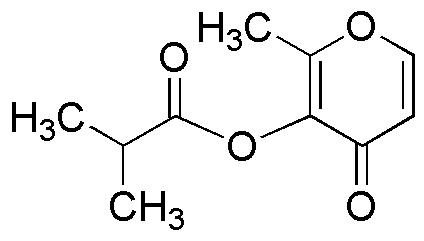Maltyl isobutyrate is widely utilized in research focused on:
- Flavoring Agents: Commonly used in the food industry, this compound provides a sweet, fruity aroma that enhances the flavor profile of various products, including candies and baked goods.
- Fragrance Formulations: In the cosmetics and personal care sector, it serves as a key ingredient in perfumes and scented products, contributing to a pleasant and appealing fragrance.
- Solvent Applications: It acts as an effective solvent in the formulation of paints and coatings, improving the application properties and drying times of these products.
- Pharmaceuticals: In the pharmaceutical industry, it is used as an excipient, aiding in the formulation of medications by enhancing solubility and stability.
- Research and Development: Researchers leverage its unique properties in various chemical syntheses and studies, particularly in the development of new materials and compounds.
General Information
Properties
Safety and Regulations
Applications
Maltyl isobutyrate is widely utilized in research focused on:
- Flavoring Agents: Commonly used in the food industry, this compound provides a sweet, fruity aroma that enhances the flavor profile of various products, including candies and baked goods.
- Fragrance Formulations: In the cosmetics and personal care sector, it serves as a key ingredient in perfumes and scented products, contributing to a pleasant and appealing fragrance.
- Solvent Applications: It acts as an effective solvent in the formulation of paints and coatings, improving the application properties and drying times of these products.
- Pharmaceuticals: In the pharmaceutical industry, it is used as an excipient, aiding in the formulation of medications by enhancing solubility and stability.
- Research and Development: Researchers leverage its unique properties in various chemical syntheses and studies, particularly in the development of new materials and compounds.
Documents
Safety Data Sheets (SDS)
The SDS provides comprehensive safety information on handling, storage, and disposal of the product.
Product Specification (PS)
The PS provides a comprehensive breakdown of the product’s properties, including chemical composition, physical state, purity, and storage requirements. It also details acceptable quality ranges and the product's intended applications.
Certificates of Analysis (COA)
Search for Certificates of Analysis (COA) by entering the products Lot Number. Lot and Batch Numbers can be found on a product’s label following the words ‘Lot’ or ‘Batch’.
*Catalog Number
*Lot Number
Certificates Of Origin (COO)
This COO confirms the country where the product was manufactured, and also details the materials and components used in it and whether it is derived from natural, synthetic, or other specific sources. This certificate may be required for customs, trade, and regulatory compliance.
*Catalog Number
*Lot Number
Safety Data Sheets (SDS)
The SDS provides comprehensive safety information on handling, storage, and disposal of the product.
DownloadProduct Specification (PS)
The PS provides a comprehensive breakdown of the product’s properties, including chemical composition, physical state, purity, and storage requirements. It also details acceptable quality ranges and the product's intended applications.
DownloadCertificates of Analysis (COA)
Search for Certificates of Analysis (COA) by entering the products Lot Number. Lot and Batch Numbers can be found on a product’s label following the words ‘Lot’ or ‘Batch’.
*Catalog Number
*Lot Number
Certificates Of Origin (COO)
This COO confirms the country where the product was manufactured, and also details the materials and components used in it and whether it is derived from natural, synthetic, or other specific sources. This certificate may be required for customs, trade, and regulatory compliance.


